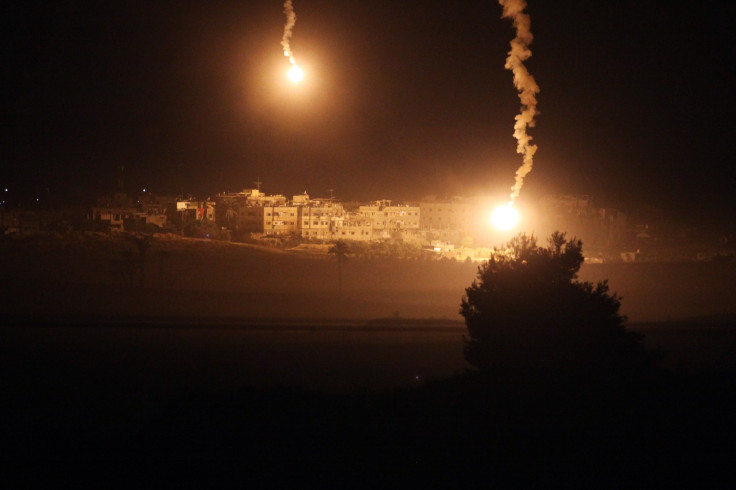Gaza Operation Could Be Over This Week, Israel Says

JERUSALEM -- The conflict in Gaza could come to a close at the end of this week, an Israeli military spokesman said Monday, as long as Israel can ensure Hamas does not rebuild its tunnels.
"By our assessment, we could be out by the end of the week, possibly the beginning of next week," Peter Lerner, a spokesman for the Israel Defense Forces, said -- provided the army completes its mission of destroying what it calls Hamas’ “terror tunnels.”
“We want to make [the mission] as widespread as possible,” Lerner said. “The longer the operation goes, the more meters of these tunnels we can clear,” adding that an IDF task force has been investigating how to detect the tunnels for the last year, and has already made significant advances in destroying them.
When Israel began a ground invasion of the Gaza Strip on July 17, for the third time in seven years, the IDF said it was going to target Hamas’ smuggling tunnels and rocket stockpiles, a similar goal to its past missions in Gaza. Each time, the IDF has said it would aim to stop rocket attacks on Israel by Hamas, a movement whose stated goal remains the annihilation of Israel. But after each invasion, Hamas rebuilds tunnels and imports or builds more rockets.
Yuval Steinitz, Israel's minister for intelligence affairs, told journalists in Jerusalem last Tuesday that Israel has found 30 tunnels and destroyed 15 of them. Lerner said that by IDF estimates, each tunnel costs $1 million on average and contains vast amounts of cement as well as wiring, electricity and conveyor belts to move supplies.
Currently the IDF uses several different units within the army and intelligence services to locate the tunnels in Gaza. One of the main groups, the Combat Engineering Corps, uses engineering equipment to deal with mines and explosives. Its Sayeret Yahalom special forces unit is responsible for addressing tunnel threats.
“There is technology to pick up and locate these type of threats,” Lerner said, adding that the IDF “is looking into developing technology that would make it easier to locate the tunnels.” He said the IDF is currently working with geologists and engineers to develop these systems, but that Hamas "most likely realizes that it is not worth it to rebuild the tunnels," Lerner said. "They were not successful in creating what they wanted and they put $30 million into creating that infrastructure."
A spokesman with the Israeli Government Press Office said that the only way Israel could ensure Hamas does not rebuild the tunnels is to create an “underground Iron Dome-like system” that would detect underground activity such as tunnel building and could immediately stop it.
The Iron Dome is a defense system that intercepts Hamas rockets launched into Israel. The radar detects rockets that are launched from Gaza and passes that information to a control center. A missile is then launched and explodes near the rocket, destroying it.
Underground tunnel detection systems are used in the U.S. on the Mexican border. According to reports from the Drug Enforcement Administration in April, the U.S. had detected 80 cross-border tunnels since 2006, most of them in California and Arizona.
According to the U.S. Border Patrol, there are four main ways to detect underground tunnels -- through seismic activity; low-frequency digging noises and tunnel transit noises, acoustic activity, or high-frequency noises; magnetic inconsistencies, which include electrical power lines in the tunnel; and soil density irregularities.
In 2012 the IDF announced that it had a solution to finding underground tunnels in the Gaza Strip. The detection system, known as the Power Number, was a sensor system that used geophones, a device that converts ground movement into voltage, placed five feet below the ground.
The system was supposed to be deployed along 10 kilometers (six miles) of the Gaza border by the end of 2013. It is unclear if the system has been put in place.
Although the IDF indicated that it could pull out by the end of the week, Lerner said that would depend on the prime minister's office. And Prime Minister Benjamin Netanyahu said Monday night in an address that his country must prepare for a long conflict in the Gaza Strip.
His address came after intense fighting in between Hamas and the IDF in northern Gaza. There were some reports that Hamas militans had found their way through the northern border and clashed with IDF soldiers. Lerner said in a tweet that the militants made their way out of Gaza into the community of Nahal Oz through a tunnel.
"We will not finish the mission, we will not finish the operation without neutralizing the tunnels, which have the sole purpose of destroying our citizens, killing our children," Netanyahu said.
© Copyright IBTimes 2025. All rights reserved.





















